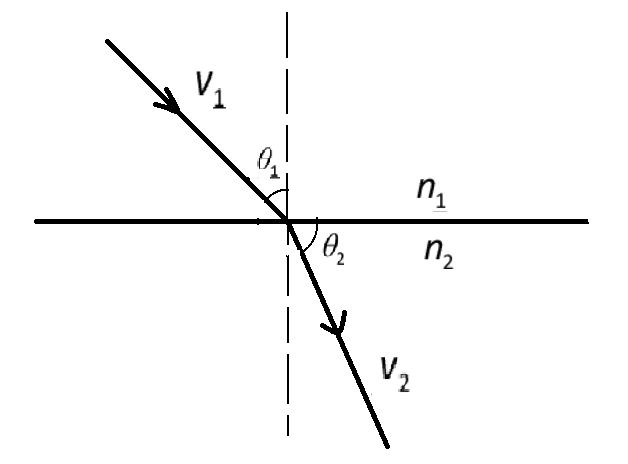Question
Question: (a)State Snell’s law for refraction of light. (b)A concave mirror forms two times magnified and re...
(a)State Snell’s law for refraction of light.
(b)A concave mirror forms two times magnified and real images of an object placed at 15cm from its pole. Determine the distance of image from the mirror and focal length of the mirror.
Solution
Snell’s law talks about the relation between incidence and refraction angles and is defined by the ratio of sinθ1sinθ2=v1v2=n2n1. In the second part we need to find the distance of distance of the image from the pole, as the distance of the object from the pole is given and the magnification is also given, so we can use m=u−v, to calculate the image distance from the pole and the focal length can be calculated by v1+u1=f1.
Complete step by step answer:
a) The light normally bends, or refracts, as light passes from one medium to another. The refraction law gives us a way to estimate how much bend is produced and it is defined by Snell’s law.
The Snell’s law is a law used to explain the relationship between incidence and refraction angles when applied to light or other waves moving across a boundary between two distinct non-opaque materials, such as water, glass or air.
Snell's law states that the sin ratio of incidence and refraction angles is equal to the ratio of phase velocities of all media or identical to the inverse ratio of refraction indices and is given by:
sinθ1sinθ2=v1v2=n2n1, where θ1 is the angle of incidence and θ2 is the angle of refraction, v1 is the speed of light in the first medium and v2 is the speed of light in the second medium, and n1 and n2 are the refractive index of medium one and medium two respectively.
b) It is given that the concave mirror forms two times magnified and real images of an object placed at 15cm from its pole.
So, u=15cm and as the image is real and the magnification is two times, therefore m=−2.
Now as,
m=u−v
Substitute, u=15cm and m=−2 in the above formula.
−2=15−v −v=−2(15) v=30cm
Therefore, the image formed is 30 cm away from the pole.
Now, as focal length is calculated by v1+u1=f1.
Now, substitute v=30cm and u=15cm in the formula v1+u1=f1 and calculate the value of focal length.
\dfrac{1}{v} + \dfrac{1}{u} = \dfrac{1}{f} \\\ \dfrac{1}{{30}} + \dfrac{1}{{15}} = \dfrac{1}{f} \\\\\dfrac{1}{f} = \dfrac{{1 + 2}}{{30}} \\\\\dfrac{1}{f} = \dfrac{3}{{30}} \\\ \dfrac{1}{f} = \dfrac{1}{{10}} \\\ f = 10\,{\text{cm}} \\\
 Therefore, the focal length of the mirror is 10 cm.
Therefore, the focal length of the mirror is 10 cm.
Note: This is a question is of ray optics, Snell’s law is the basis of ray optics, it is defined for both reflection and refraction and the second part is focusing on the image formation where we need to find the image distance using m=u−v and we can calculate focal length using the formula v1+u1=f1.
